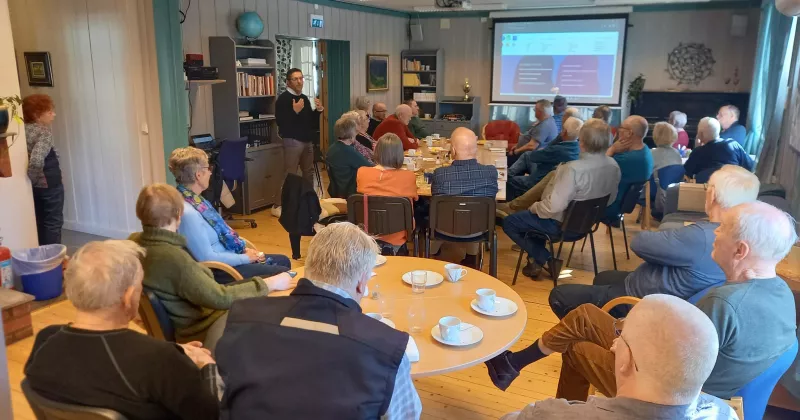M. Carmen Medina Bermejo, a Community Story from Spain

As a French teacher for more than 30 years, I started my career in secondary and vocational teaching schools. Currently I work at the Official School of Languages (EOI) in Ponferrada (Spain), where I am Head of the French department and the ERASMUS coordinator. EOIs are non-compulsory state education centers embedded in lifelong learning programs exclusively devoted to teaching foreign languages (from A1 to C1 in our school). Our students, who come from a variety of educational backgrounds (teenagers, liberal professionals, civil servants, ...), and who vary in age (anyone from 14/16 years old is welcome) and interests, are principally adults who are looking to get ready for their career, improve their CV with a prestigious academic certification or who wish to remain intellectually and socially active once their working life has come to an end. All these characteristics bring a strong sense of variety to our classes and attendance is not always consistent.
I found out about EPALE through the Erasmus program. We used the platform to find partners for our Erasmus projects and to get to know other adult education centers in Europe and to learn more about their way of working. I also often use EPALE to keep up to date on what is going on in the field of foreign language teaching, and to look for inspiration for activities and good practices.
The COVID-19 emergency has forced me to approach my work differently and has shown me once again that taking care of human relationships and working on good group communication from the outset with the members of the group makes life a lot easier.
Our School has had a virtual platform for a long time. This platform is provided by our Regional Educational Authority (Junta de Castilla y León) and complements the face-to-face lessons. Each of my groups has its own virtual classroom, organised according to the thematic units used during the face-to-face teaching, plus some specific support or additional units. My courses on the platform contain all the materials seen in class and those that are not in the coursebook (mostly audiovisual). They also offer interactive review activities that help reinforce new content and I recommend that my students use fora and wikis to practise their writing skills and share documents. According to our school rules, these virtual classrooms go live at the beginning of the course, and each teacher goes with his/her students to the multimedia laboratory to present the platform and train the students in how to navigate it. Despite this, the virtual classroom is usually used by the most dedicated students and those who regularly attend lessons, while most students don’t use the platform.
However, everything changed with the COVID-19 lockdown
As soon as the face-to-face classes stopped, all my students had to get used to the Moodle platform. Many were unsure about how to use it, which only made a hard situation more difficult. This was not good news for the students’ learning. Some had forgotten their email address or password, others had forgotten how to access the platform and, even when they managed to access t, they did not know how to navigate it or where to find documents ...
But it was not all bad news. The healthy relationship between teachers and students has favoured a collaborative work flow and brought the members of each class, their teachers and the centre closer together. The administrative staff sent the students all the academic information puntually, the study plan for each class was updated each week, and the delegates and sub-delegates sent them out and made a summary of what was discussed in each session. Furthermore, the students who knew how to use Moodle helped those who didn’t and I remained in constant contact with all of my students through my work email, personal email, private chat, phone calls (using private number) etc.
The important thing was to keep communicating so that the students did not feel that they were facing this unexpected challenge alone.
It should be noted that although a WhatsApp group was created for each class at the beginning of the course, only the regular students were in it. This was one of the first measures that delegates were asked to do: include everyone in the WhatsApp group. Even sub-groups were created based on what digital tool was available to them (tablet, telephone or computer). But it is important to be very careful, as these groups can become a double-edged sword. To avoid misunderstandings, the information must be fluid, clear and precise, and well documented (a screenshot of the exercise, an email reminder...). Personally, I had never been part of a WhatsApp group before, but this experience has shown me that the election of the group student representatives (delegates) that takes place during the first month of the course, as a mere administrative task, can have important consequences.
It was not only the students who had to get used to using digital tools. As a teacher, I was forced to learn how to use them for the first time because I had never taught online before.
The first thing I had to figure out was which tool to use for the virtual lessons and then I had to learn how to teach online. To find out which tool to use, I attended meetings (coordination between school teachers is essential), I signed up to webinars, watched tutorials, read articles, and spent endless hours sat in front of the computer. I had to be completely sure that I knew how the chosen platform worked (in my case, 8x8).
In terms of online teaching, I still haven’t found what I am looking for.
Needless to say that an online class is not the same as a face-to-face one. It requires not only technical knowledge of the management of the platform (Teams, Zoom, 8x8, Google Classroom or any other) and a good wifi connection, but also, and above all, a methodology and a different « savoir-faire ».
In addition to the already great variety within the group, we now need to bear in mind technoological disparancies, the time, images, spaces.
Within a group we can have students who have access to all available devices, students who have a good connection and a good computer, with whom you can have a « live » conversation and share your screen without any problem. Others may have delayed sound and image issues, they may be able to hear and see but their microphone may not work and therefore they can only participate by writing. Others still may be able to see, but have difficulties with sound; or they can only see a blurred screen, but have good sound… There are those who continue to attend classes from the first day and those who, having disappeared from face-to-face classes, now attend the online classes as this online environment gives them the flexibilty and spatial organisation which they need. Some students were able to connect alone in their room while others followed the lessons with their grandson on their knee, the canary singing or the TV on in the background.
As in the face-to-face class, I have proposed parallel and simultaneous activities so that everyone reaches the same point. I have split the session between the different linguistic activities, I have tried to keep my students interested in and motivated by the course content. We have also managed different times and worked at different speeds (slower than in the face-to-face lessons), we have constantly repeated what we have said, we have invited everyone to participate, without leaving anyone out ... And I have made sure over and over again that everyone has understood, heard, and listened to each other, even if we cannot see each other….
This is just the beginning ... I will keep learning.






The reality of the 2020